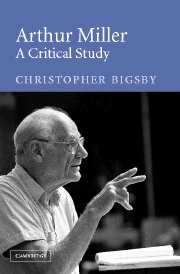Book contents
- Frontmatter
- Contents
- Acknowledgements
- Note on the text
- Introduction
- 1 The Michigan plays
- 2 The Golden Years, The Half-Bridge, Boro Hall Nocturne
- 3 The radio plays
- 4 The Man Who Had All the Luck
- 5 Focus
- 6 All My Sons
- 7 Death of a Salesman
- 8 Arthur Miller: time-traveller
- 9 An Enemy of the People
- 10 The Crucible
- 11 A Memory of Two Mondays
- 12 A View from the Bridge
- 13 Tragedy
- 14 The Misfits
- 15 After the Fall
- 16 Incident at Vichy
- 17 The Price
- 18 The Creation of the World and Other Business
- 19 The Archbishop's Ceiling
- 20 Playing for Time
- 21 The shearing point
- 22 The American Clock
- 23 The one-act plays: Two-Way Mirror, and Danger: Memory!
- 24 The Ride Down Mount Morgan
- 25 The Last Yankee
- 26 Broken Glass
- 27 Mr Peters' Connections
- 28 Resurrection Blues
- 29 Finishing the Picture
- 30 Fiction
- 31 Arthur Miller as a Jewish writer
- Notes
- Index
8 - Arthur Miller: time-traveller
Published online by Cambridge University Press: 16 November 2009
- Frontmatter
- Contents
- Acknowledgements
- Note on the text
- Introduction
- 1 The Michigan plays
- 2 The Golden Years, The Half-Bridge, Boro Hall Nocturne
- 3 The radio plays
- 4 The Man Who Had All the Luck
- 5 Focus
- 6 All My Sons
- 7 Death of a Salesman
- 8 Arthur Miller: time-traveller
- 9 An Enemy of the People
- 10 The Crucible
- 11 A Memory of Two Mondays
- 12 A View from the Bridge
- 13 Tragedy
- 14 The Misfits
- 15 After the Fall
- 16 Incident at Vichy
- 17 The Price
- 18 The Creation of the World and Other Business
- 19 The Archbishop's Ceiling
- 20 Playing for Time
- 21 The shearing point
- 22 The American Clock
- 23 The one-act plays: Two-Way Mirror, and Danger: Memory!
- 24 The Ride Down Mount Morgan
- 25 The Last Yankee
- 26 Broken Glass
- 27 Mr Peters' Connections
- 28 Resurrection Blues
- 29 Finishing the Picture
- 30 Fiction
- 31 Arthur Miller as a Jewish writer
- Notes
- Index
Summary
In an article published in Harper's Magazine, in March 1999, Arthur Miller insists that ‘there is no such thing as “reality” in any theatrical exhibition that can properly be called a play. The reason for this is that stage time is not, and cannot be, street time. In street time, Willy Loman's story would take sixty-two years to play out instead of two and a half hours … with the very act of condensation the artificial enters even as the first of its lines is being written.’
Time and reality, then, are intimately related, while to enter a theatre is to acknowledge that we enter a time warp in which the normal laws of physics no longer apply. Time flows at a speed determined by the author. The price of entry into this world is that we experience a temporal anomaly in which past and present may co-exist within a factitious moment. And few writers have been as interested in time, and its various ramifications, as Arthur Miller – time, that is, as history, time as memory, time as a component of identity, as productive of guilt, nostalgia, hope, psychological and social imperatives. Even his concern with shaping language, with moulding speech into distinctive rhythms, is an aspect of his concern with time for, as Sam Shepard has remarked, ‘rhythm is the delineation of time in space’.
In his preface to Salesman at Fifty, Arthur Miller says, ‘As far as I know, nobody has figured out time. Not chronological time, of course – that's merely what the calendar tells – but real time, the kind that baffles the human mind.’
- Type
- Chapter
- Information
- Arthur MillerA Critical Study, pp. 124 - 137Publisher: Cambridge University PressPrint publication year: 2004



